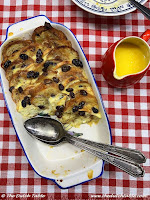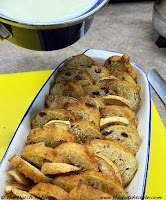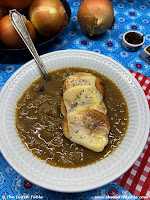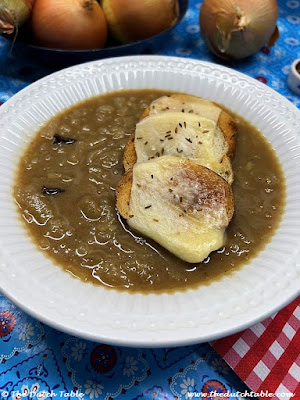There are also other ways of using up old bread, like in today's dish: a bread pudding, or broodschoteltje (bread dish), made with raisin bread, apple, eggs, milk and sugar. In my search of traditional recipes, I frequently come across dishes that use up "restjes", leftovers, from the previous day. Any meat left from the Sunday dinner will be served as a cold cut, in a huzarensalade, or turned into croquettes the next day. Vegetables are repurposed into salads or soups, and bread is turned into wentelteefjes (French toast) or broodschoteltjes. From having lived in other countries and among other cultures, I know that this is not unique to the Dutch, but I do think that we take a particular pride in being thrifty, or zuinig.
And we have plenty of sayings to support being thrifty: in Limburg they say "dae twieë zwegelkes noeëdig heet um zien piêp aan te staeke, weurtj noeëts riêk" (he who needs two matches to light his pipe, will never be rich), in de Achterhoek it's said that "dunne plekskes sniën, is ' t behold van de wörste" (cutting thin slices preserves the sausages), and in Zeeland, "oans bin zunig" (we are thrifty). This last one even inspired various margarine commercials in the 80s.
Well, I'm not from Zeeland, but I do like to be zuinig or deliberate in my spending, so this morning I am using up the rest of the rozijnenbrood to make a bread pudding. If you don't have rozijnenbrood, just use regular old bread and add a handful of raisins. Don't have an apple? See if you can scrounge up a pear, or use dried fruits like apricots. Even dollops of the last of the strawberry jam will make a great addition: just have fun with it! As they say in de Achterhoek: "Wa’j ow spaort veur de mond, is vake veur de katte of de hond" - what you save for your mouth, often ends up being for the cat or the dog. A great encouragement to look through the cupboards and fridge to see what can get used up, in true Dutch fashion.Rozijnenbroodschoteltje met appel
Pour the hot milk over the bread and apple mix. If you want a bread pudding with a crispy top, do not mix, otherwise give it a stir or two so that all the bread is covered. When the oven is up to temp, place the casserole on the middle rack, and bake it for 40-45 minutes or until golden.
Serve hot. I like to add a pat of butter or a splash of heavy cream, but it doesn't need it (then again, neither do I, but there you have it :-).






































